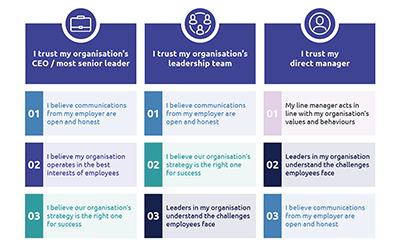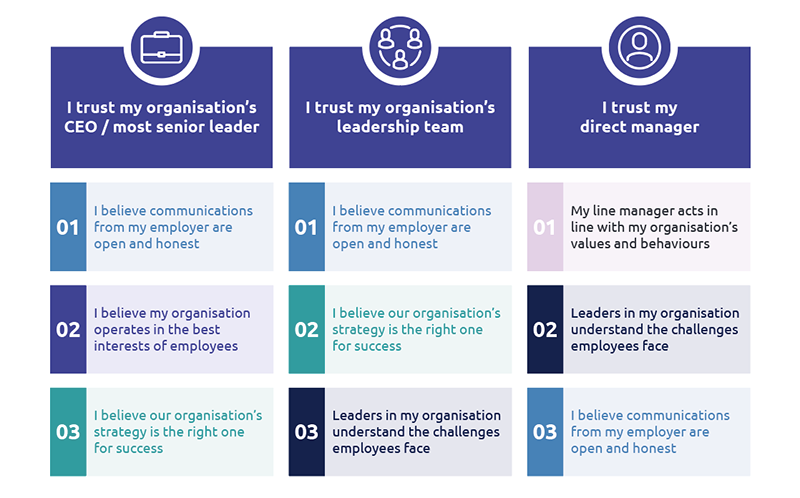Why do we need trust in the workplace?
It’s a word that gets thrown around a lot, but put simply trust is essential to unlocking high performance. Teams with high levels of trust are more likely to share ideas, collaborate effectively, ask for help, and make better decisions. In short, they outperform teams who lack trust, especially in leadership.
Trust is known to enhance employees’ confidence in an organisation’s strategy, thereby improving resilience to change and instability. But that’s not all. Trust also fosters a culture of psychological safety where employees feel able to take calculated risks that can lead to innovation and continuous improvement. Without trust, there is cynicism and stagnation.
As ongoing change is fast becoming the new normal, building and sustaining strong levels of trust is more important, yet much harder, than ever before. In 2024, amidst a backdrop of geopolitical and economic uncertainty, trust in business leaders was only 6% higher than that in government officials – highlighting a worrying lack of faith in leadership across sectors.
Using insights from our 2024 research with the Institute of Internal Communication (IoIC), this article explores what influences workplace trust, how to assess it, and most critically, how to (re)build it.
What drives trust in CEOs, leadership teams and managers



Source: IC Index 2024 by Ipsos Karian and Box and the Institute of Internal Communication
The higher you go, the less trusted you are.
Trust in leaders diminishes the higher you climb in an organisation, but our research shows the factors influencing trust vary for CEOs, senior leadership teams, and line managers.
Open and honest communication impacts trust across all levels but is particularly important for trust in CEOs. Transparent communication, no matter the story, is seen to not only inspire trust in leaders, but also belief in an organisation's direction – a critical factor in maintaining resilience during instability.
In fact, the power of good communication goes further than just authenticity. Employees who rate internal communications as ‘good’ or ‘excellent’ report greater levels of trust across all leadership levels. But there’s work to be done as just under half of internal communications professionals (49%) agreed their leaders are effective communicators.
One area of focus is empathy, a factor that sits hand in hand with transparency. Employees need to see that leaders understand their daily challenges as much as they need to believe their organisation’s strategy is the right one and does the best by them.
For line managers, trust is more reliant on walking the talk and communicating frequently. This means role-modelling the behaviours they preach, being accessible, holding regular check-ins, and proactively addressing concerns.
These seemingly small yet significant nuances highlight the need for targeted actions to drive trust at all levels of the organisation.
To build trust, meet it head on.
Measuring trust through a combination of surveys, interviews and indirect measures will help to provide a full picture of how employees really feel so you can make tangible improvements.
These surveys need to go beyond surface-level satisfaction. You can do that by asking explicit questions that address different leadership levels, e.g., “I trust the communications I receive from my organisation’s CEO”. The results may be confronting, but they’ll allow for targeted actions going forward.
To move one step closer to richer insights, conduct interviews with a diverse group of employees. This will help you draw out individual experiences based on where an employee sits in an organisation.
And finally, use indirect indicators. This underrated resource looks at factors such as retention levels, employee engagement and team performance to provide an unfiltered, outcome-based lens to see where intra-organisational trust is high and unearth potential issues.
Change changes everything.
We can all say from experience that things can change in an instant. Trust is no different – what can take years to build can be lost overnight.
Restructuring and transformation has a direct impact on employees’ trust in their organisation and leadership. This echoes findings from last year’s IC Index that show communication sits at the heart of what differentiates organisations that do change well – by bringing employees on the journey and inspiring hearts and minds – and those who don’t.
Effective measurement therefore serves as an early warning signal. By monitoring sentiment on a regular basis, you’ll be better placed to react to shifts in response to internal and external events. These insights should be used to craft frequent, transparent communications that demonstrate empathy.
The bottom line.
Trust is no longer a 'nice-to-have' but a business imperative. Organisations that prioritise building and nurturing trust through robust measurement strategies will reap the rewards of higher performance, increased innovation, and a more engaged and resilient workforce. That is the secret to creating a workplace where trust thrives, even amidst uncertainty.
Our trust series continues next week as we look at the four ‘trust types’ from our 2024 research and how they impact internal communications.
Emily Cooke







